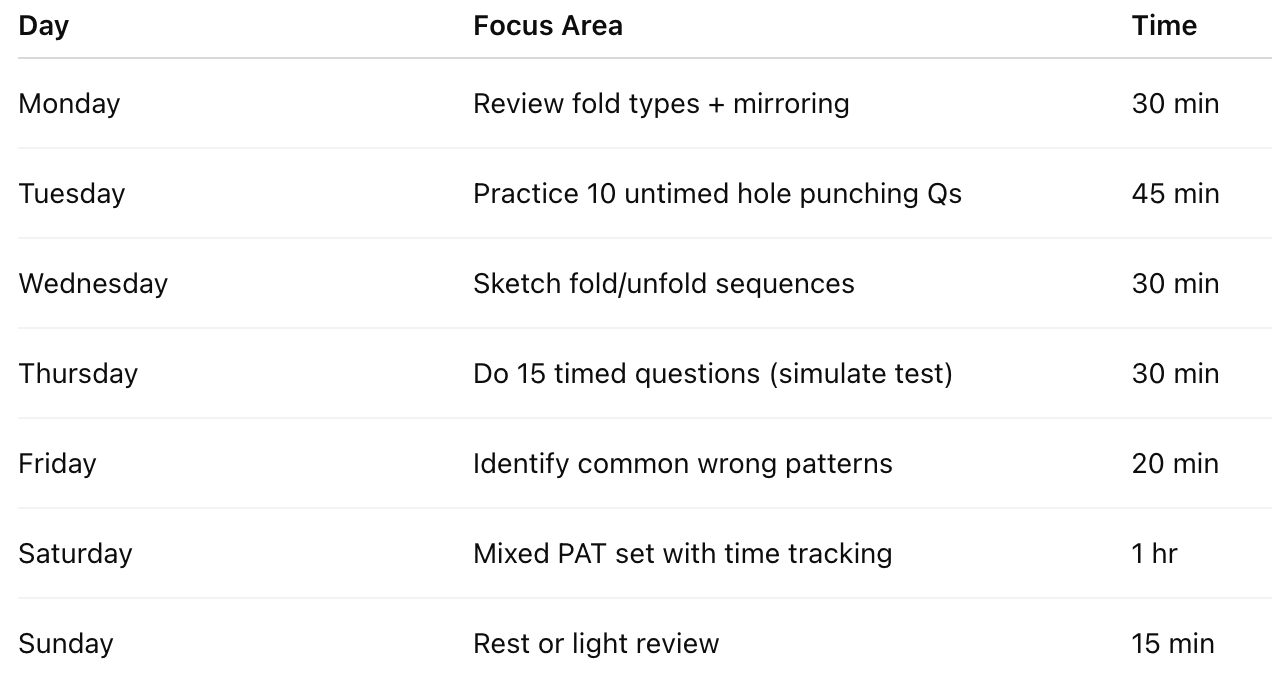Hole Punching Tips That Actually Work: Avoid Common Mistakes
Master This Tricky PAT Subsection on the DAT With Confidence and Accuracy
Struggling with the hole punching section of the DAT PAT? Learn the best strategies, common mistakes to avoid, and proven tips that actually work to improve your accuracy and speed.
If you're preparing for the Perceptual Ability Test (PAT) on the Dental Admission Test (DAT), the Hole Punching section might seem deceptively simple at first glance. After all, it’s just predicting where holes will appear on a folded piece of paper—right?
But if you’ve taken a few practice tests, you know how quickly small errors can cost you points. Many students struggle with mirrored folds, spatial reasoning, and time pressure. The good news? With the right visual strategies and practice, hole punching can become one of your highest-scoring PAT sections.
In this guide, you’ll learn:
What the Hole Punching section is all about
Why students make avoidable mistakes
Visual tricks and strategies that actually work
Practice tips that build consistency and confidence
🧠 What Is the Hole Punching Section on the DAT?
In the Hole Punching section, you're given a square piece of paper that has been folded one to three times, and then a hole is punched through the folded paper. Your task is to mentally unfold the paper and determine where the holes will appear on the fully unfolded sheet.
There are 15 hole punching questions, and they test your ability to:
Visualize folds and symmetry
Understand spatial transformations
Track mirrored positions
Work under strict time constraints
❌ Common Mistakes Students Make (and How to Avoid Them)
Before diving into what works, let’s look at what doesn’t. These are the most common hole punching pitfalls:
1. Forgetting to Mirror the Holes Correctly
Students often unfold the paper mentally but forget that every fold creates a mirror image. This causes them to place the hole on the wrong side.
✅ Fix: Always mirror across each fold line, starting from the last fold and working backward.
2. Not Following the Fold Sequence
When more than one fold is involved, students try to guess the unfolded pattern without reversing the fold order. This leads to incorrect positioning of the holes.
✅ Fix: Remember, unfold in reverse order—last fold undone first, then second-to-last, and so on.
3. Trying to Visualize Everything at Once
Your brain can only track so many transformations at a time. When you try to visualize all folds and holes simultaneously, it gets confusing fast.
✅ Fix: Break the process down. Unfold one fold at a time, and track the hole's position step-by-step.
4. Wasting Time on Easy Questions
Hole punching questions vary in complexity, but many are straightforward. Some students overthink the simple ones and lose valuable time for harder problems.
✅ Fix: Flag trickier ones and return later if needed. Trust your instincts on obvious answers.
✅ Hole Punching Tips That Actually Work
Now that you know what to avoid, here are proven strategies to master the Hole Punching section:
1. Use the Grid Method
Mentally divide the square into a 4x4 grid. This is how answers are laid out, and it gives you a visual reference to mirror holes accurately.
Each square on the grid corresponds to a possible location of a hole, so this helps eliminate guessing.
2. Count the Folds
Ask yourself:
How many folds are there?
In what directions are they made? (left, right, top, bottom)
Folding directions determine how holes are mirrored, so get clear on this first before solving.
3. Reverse Engineer the Unfold
Always unfold one step at a time. If you try to visualize all at once, you're more likely to make mistakes.
After each “unfold,” mirror the hole accordingly. Repeat this until the paper is flat.
4. Use Your Pencil to Sketch
While you can't draw on the DAT itself, using scratch paper to sketch a grid and mirror steps is extremely helpful during practice.
Over time, you’ll rely on sketching less and develop stronger mental visualization.
5. Practice with Real Paper
Physically fold and punch a paper square, then unfold it to see where the holes appear. This hands-on practice reinforces mental patterns and symmetry.
The more you do this, the better your brain gets at predicting hole locations without guessing.
⏱️ Timing Strategy: Maximize Accuracy Under Pressure
Aim for 45–60 seconds per question.
Start with single-fold questions to build confidence.
Gradually work up to three-fold questions under time constraints.
Flag time-consuming ones to revisit at the end.
🔁 Practice Routine to Sharpen Your Skills
Here’s a quick weekly practice structure:
🧰 Best Tools for Hole Punching Practice
DATBooster – Excellent for timed hole punching drills and strategy videos.
Bootcamp PAT Generator – Randomized patterns and fold orientations.
PATCrusher – Breaks down your accuracy by fold type and mistake pattern.
Paper folding apps or 3D net builders – Use them to simulate real-world folding virtually.
🦷 Why Hole Punching Matters for Future Dentists
Dentists use spatial skills constantly—from interpreting X-rays to evaluating tooth positioning and symmetry. Hole Punching trains:
Visual mapping
Predictive symmetry
Mental rotation and reversal
So mastering this section is more than a test—it’s a step toward becoming a highly skilled clinician.
🚀 Final Takeaway: Practice With Purpose
Hole Punching is one of the most trainable sections of the PAT. With the right strategies—like using the grid method, practicing mirroring, and breaking folds into steps—you can eliminate mistakes and boost your score dramatically.
Get Expert Help With PAT Strategy
At Dental School Declassified, our elite tutors scored in the 98th percentile or higher on the DAT. We offer:
Personalized PAT tutoring (including hole punching)
Real-time strategy sessions with expert feedback
Weekly accountability and study plans
